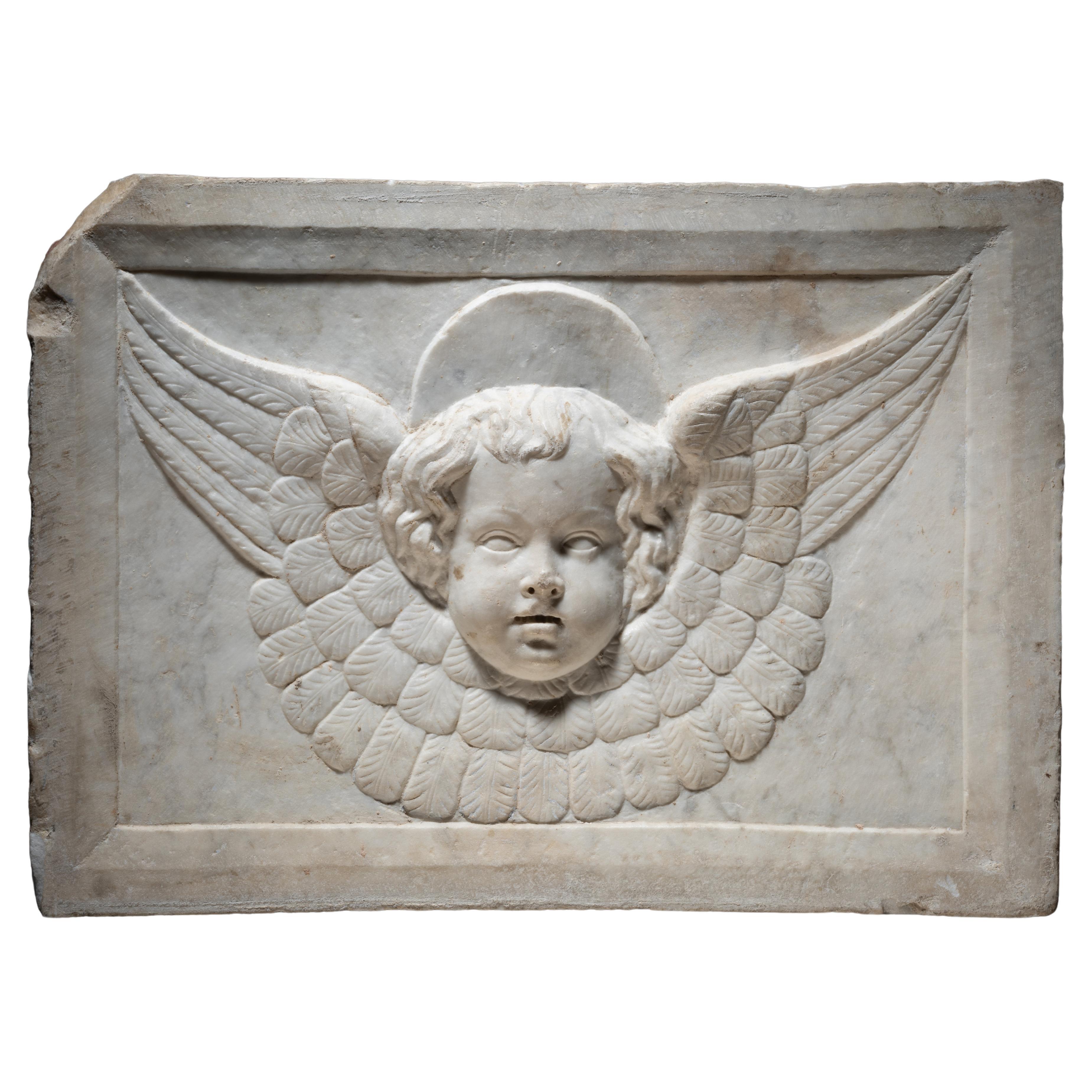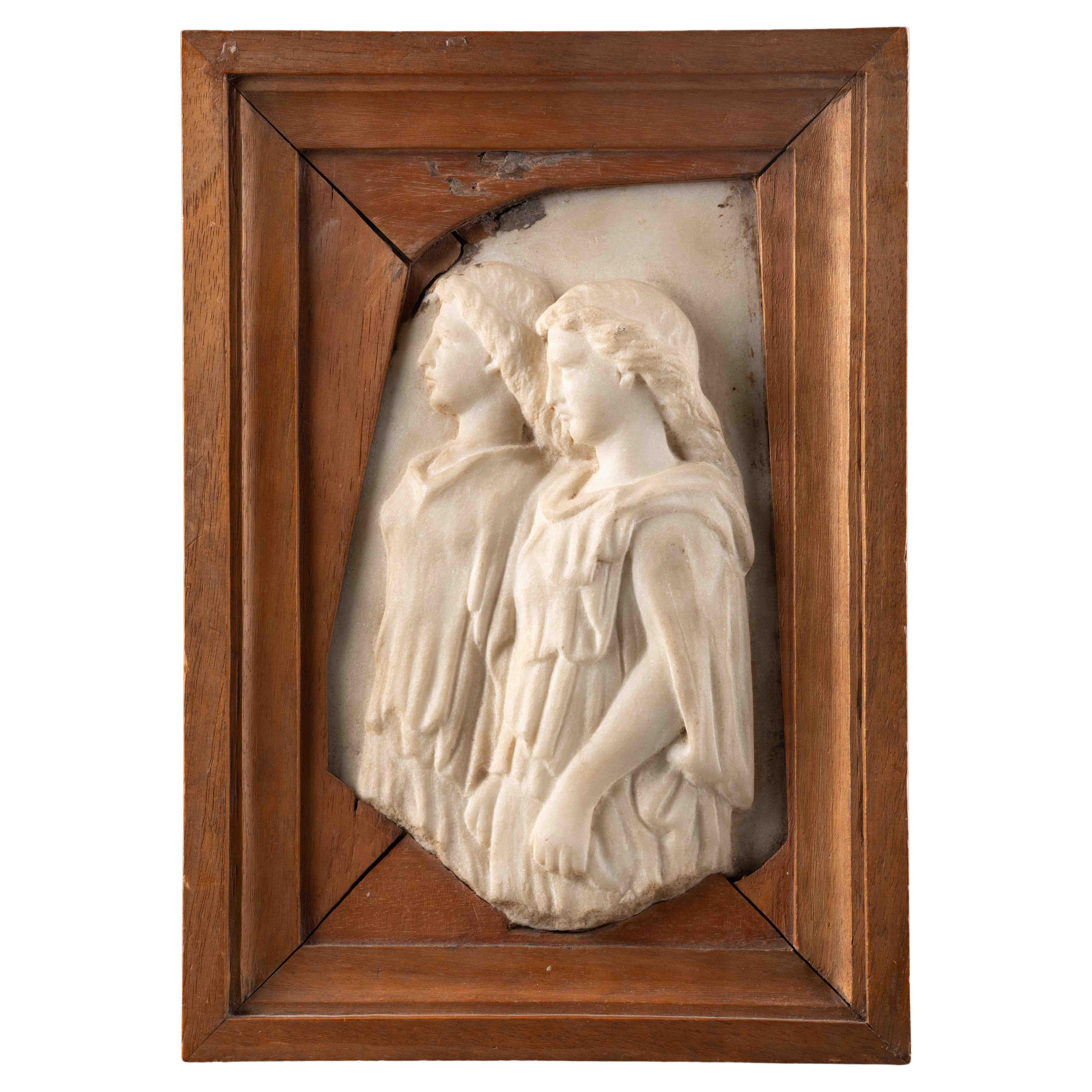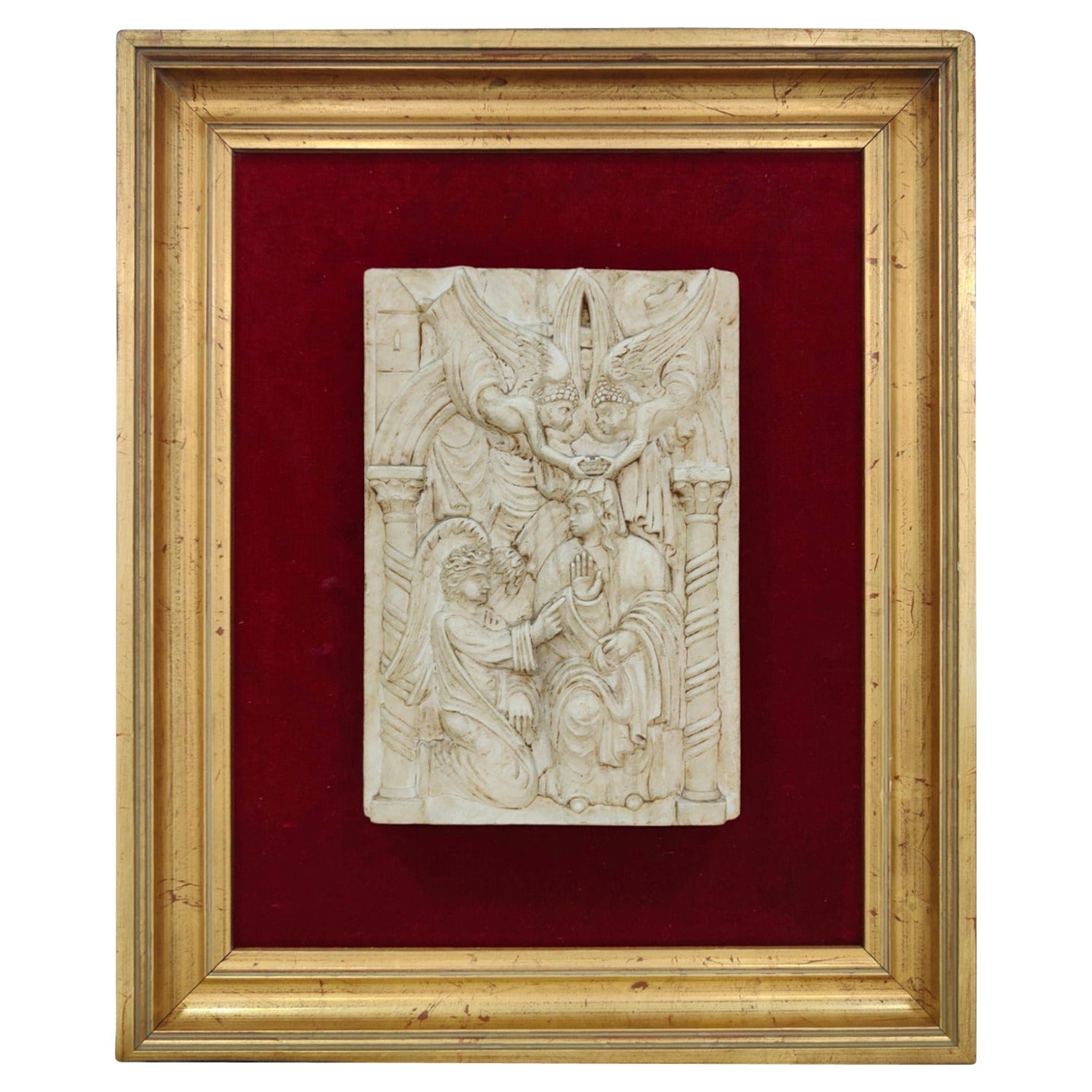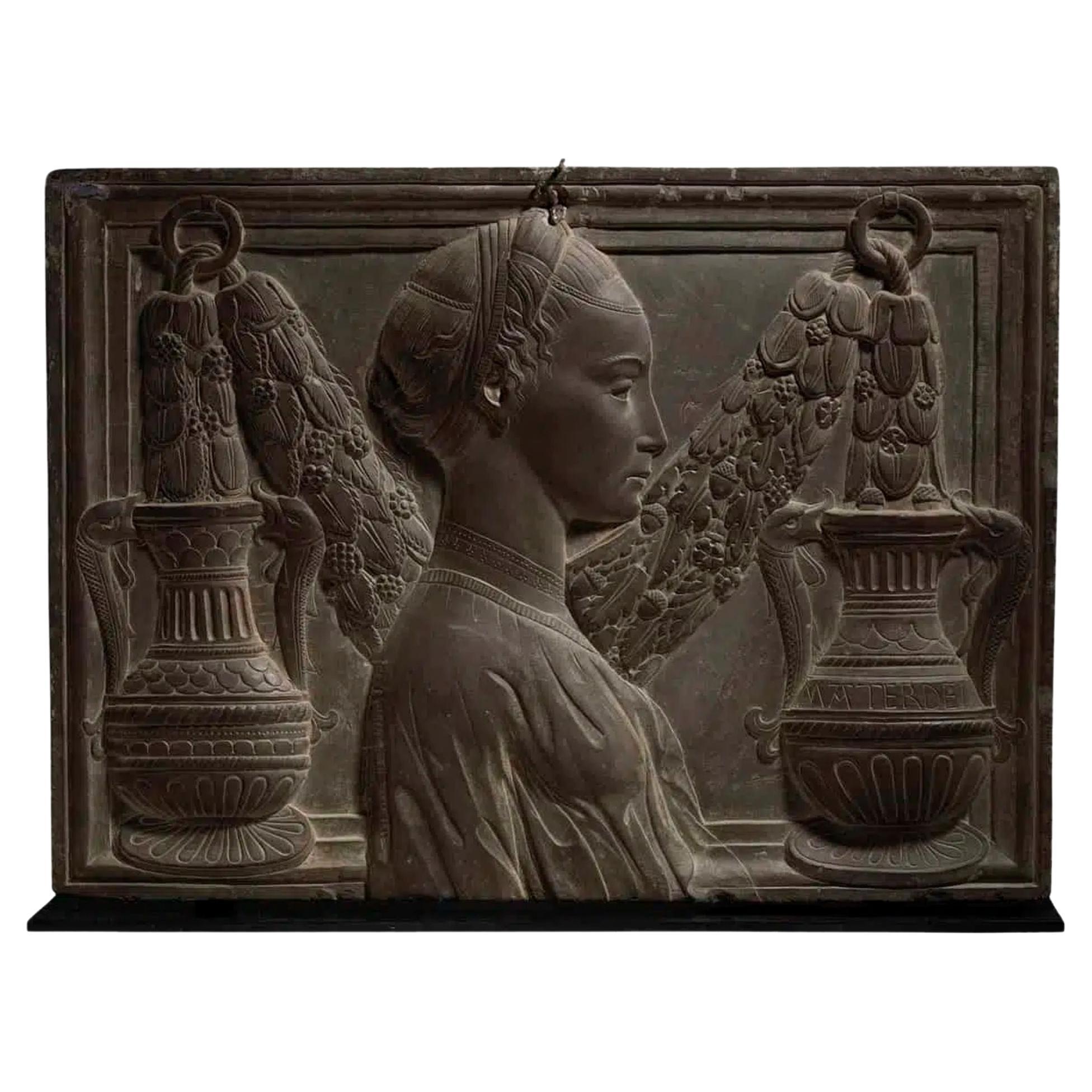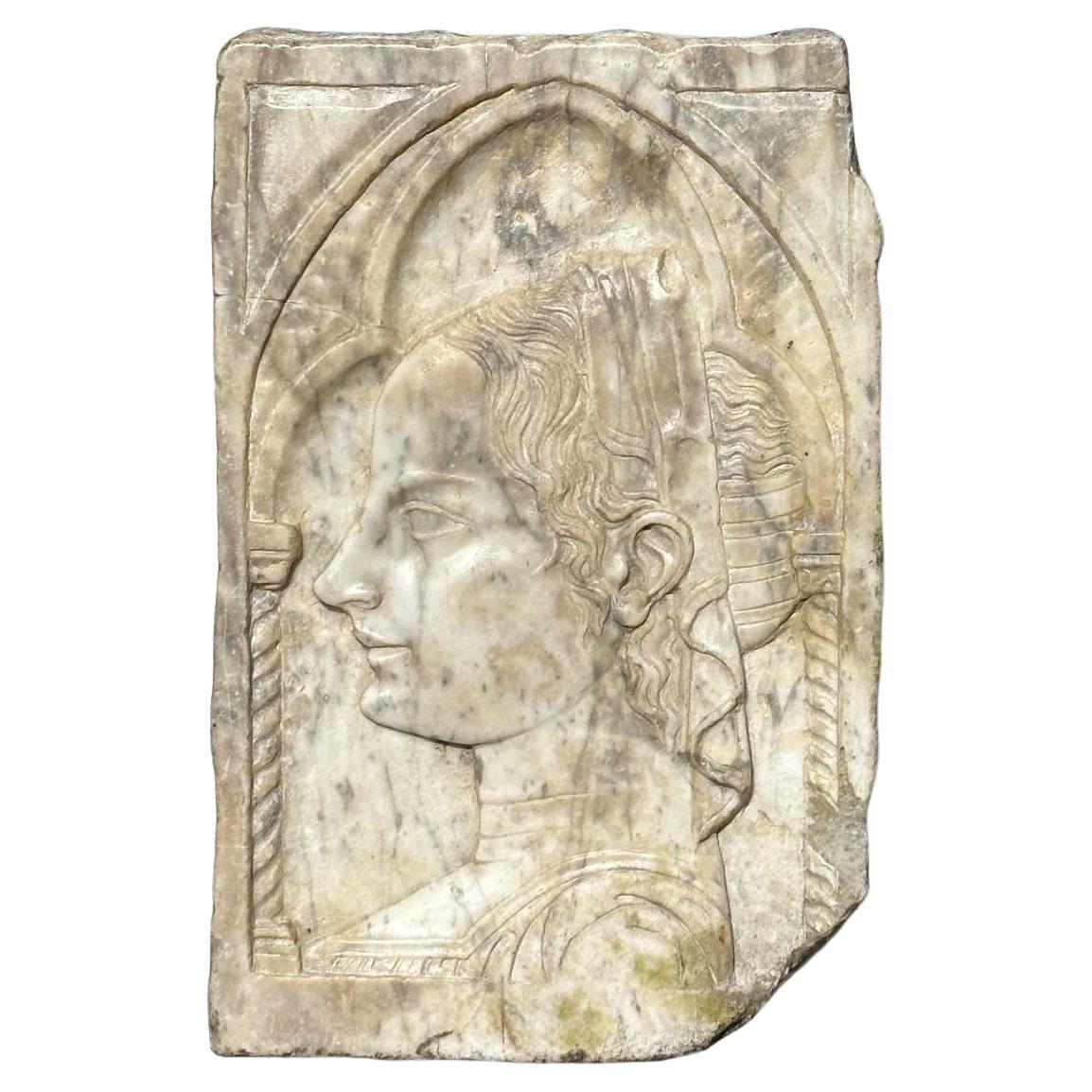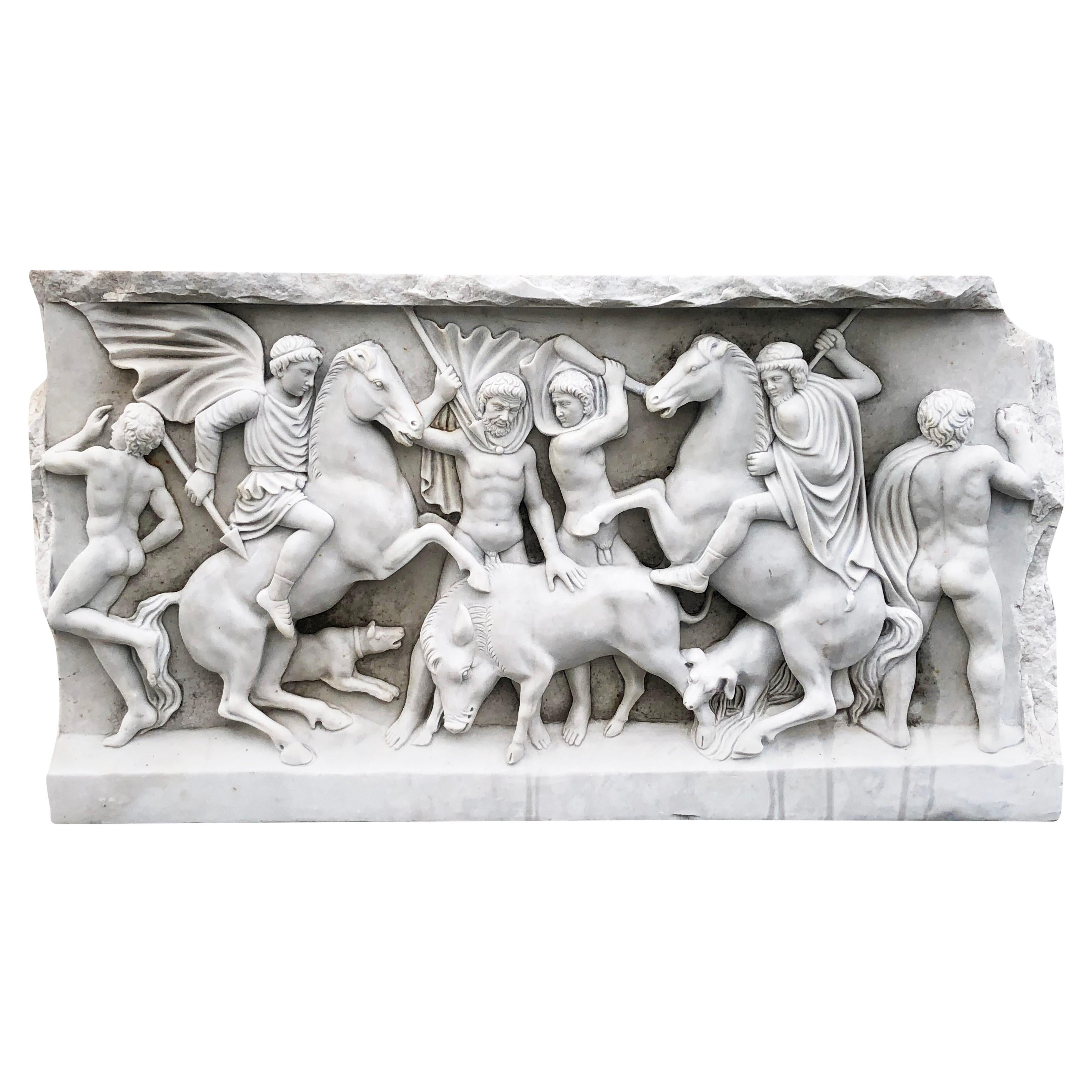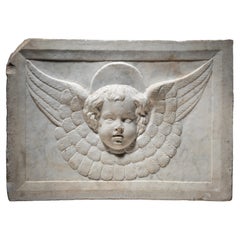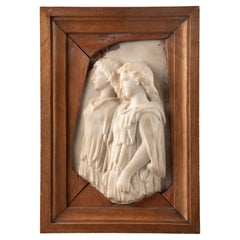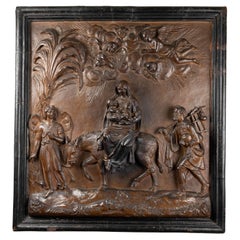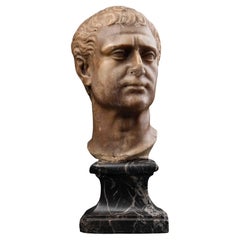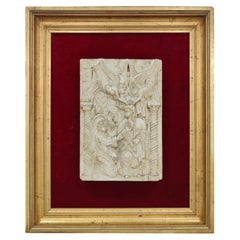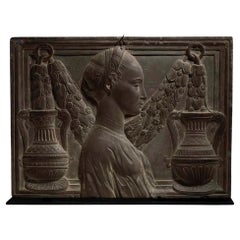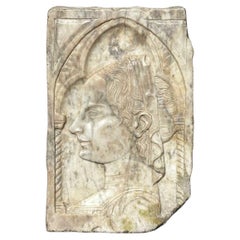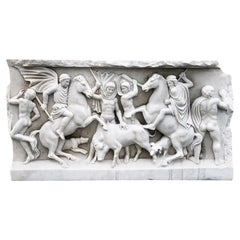Items Similar to Renaissance Marble Relief - Emilia Romagna, 1470-80
Want more images or videos?
Request additional images or videos from the seller
1 of 5
Renaissance Marble Relief - Emilia Romagna, 1470-80
$41,715.45
£30,890.04
€35,000
CA$57,365
A$63,804.62
CHF 33,393.97
MX$778,205.92
NOK 419,607.38
SEK 394,694.92
DKK 266,465.79
About the Item
Renaissance Marble Relief
Emilia Romagna, Faenza ? 1470-80
H 30,2 x L 33 x P 3,5 cm
The carved marble relief depicts the Virgin accompanied by a winged cherub standing behind her. The relief is set within a concave circle, where the Virgin's face occupies the deepest part. The lower portion of the panel rests on two vegetal volutes terminating in a compartmentalized rectangular base. The contemplative Virgin, with partially open eyelids, turns her gaze away from the viewer as she slightly tilts to her left; the slight inclination of the Virgin's face and the cherub appearing to her right create a triangular composition that harmoniously fits within the enclosing circle. The veil surrounding the Madonna's face is formed by almost fluid parallel folds; the fabrics and their undulations serve to attract and guide the viewer's gaze, creating plastic volumes that catch the light and deepen into shadows, thus structuring the representation's space. The drapery of the veil here serves to magnify Mary and amplify her presence.
Typical of late Quattrocento sculpture in central-northern Italy is the extraordinary craftsmanship of carved marble, which is folded and elegantly fluid. The reduced format of the panel suggests its origin either as a small anconette linked to private devotion or as a predella of a marble altarpiece. The work exhibits typical stylistic elements of Florentine culture from the early Renaissance in the Virgin's proud posture and in the judicious use of relief, deeper in the Virgin's face and less pronounced in the face of the angel in the background.
This relief was created during a pivotal period, the second half of the 15th century, considered the pinnacle of the Renaissance, when the new style invented by Donatello and the Florentine sculptors of the early 15th century reached maturity. Influenced by Donatello's teachings, this relief demonstrates a renewed attention to works of Antiquity. It is still attributed to Donatello to have shown that such models could effectively be adopted not only in subjects "à l'antique" but also in sacred subjects. The work embodies the main themes and trends that pervade Italy during the second half of the Quattrocento. It is imbued with serene grace; the pursuit of balance is manifested in an art intended for reflection and the pleasure of patrons. Ancient models, calmer and more harmonious, are brought up to date thanks to the emphasis placed on inner and emotional processes. The classicism of ancient sources and subjects is transcended by a poetic vision of beauty. This new stylistic orientation, characterized by soft and peaceful forms, draws inspiration from antiquity while quickly being surpassed by a great freedom of personal reinterpretation. Sculpture develops the search for a new harmony that transcends the naturalism of gestures and extreme sentiments. To move and convince become the two aims of religious sculpture in the second half of the Quattrocento, aiming to touch the intimate springs of the viewer's soul.
- Dimensions:Height: 9.45 in (24 cm)Width: 13 in (33 cm)Depth: 1.38 in (3.5 cm)
- Style:Renaissance (Of the Period)
- Materials and Techniques:
- Place of Origin:
- Period:
- Date of Manufacture:15th century
- Condition:Wear consistent with age and use.
- Seller Location:Bruxelles, BE
- Reference Number:1stDibs: LU6666239618922
About the Seller
5.0
Vetted Professional Seller
Every seller passes strict standards for authenticity and reliability
1stDibs seller since 2022
15 sales on 1stDibs
Typical response time: 1 hour
- ShippingRetrieving quote...Shipping from: Bruxelles, Belgium
- Return Policy
Authenticity Guarantee
In the unlikely event there’s an issue with an item’s authenticity, contact us within 1 year for a full refund. DetailsMoney-Back Guarantee
If your item is not as described, is damaged in transit, or does not arrive, contact us within 7 days for a full refund. Details24-Hour Cancellation
You have a 24-hour grace period in which to reconsider your purchase, with no questions asked.Vetted Professional Sellers
Our world-class sellers must adhere to strict standards for service and quality, maintaining the integrity of our listings.Price-Match Guarantee
If you find that a seller listed the same item for a lower price elsewhere, we’ll match it.Trusted Global Delivery
Our best-in-class carrier network provides specialized shipping options worldwide, including custom delivery.More From This Seller
View AllCercle of Jacopo della Pila - Marble relief depicting a winged Cherub
Located in Bruxelles, BE
Cercle of Jacopo della Pila (Lombard, in Naples 1471-1502)
Marble relief depicting a winged Cherub
Naples, second half of15th century
40 x 57 x 12 cm
Exquisitely carved, this relief portrays a winged cherub with cascading hair and delicate features. The cherub's plump, smooth countenance, rounded cheeks, outlined lips, and finely drawn nose emanate a sense of tenderness. The quadrangular module, is adorned with a carved frame. The relief ascends gradually, transitioning from the low relief of the wings to the high relief of the head.
The rectangular frame and the subtly curved form of the artwork suggest that the relief likely adorned the upper part of an arch or a vaulted chapel. The type is that of the perspective room with a coffered ceiling decorated with figures of winged cherubs, which is found in various Neapolitan chapels of the 15th century. Coffered ceilings attest to the recovery of antiquity and the search for luxury in Renaissance architecture, first in Florence, then in Rome and Naples. The majority of the numerous family chapels and tombs built during the late fifteenth century in south of Italy employ the new formal vocabulary of the Florentine Renaissance in a self-confident manner that permitted a broad spectrum of variations.
The escalating admiration for the classical world, coupled with the development of perspective, significantly contributed to the Renaissance endorsement of coffered ceilings. This artistic and constructive device drew inspiration from the intricate marble patterns observed in historical landmarks such as the Arch of Titus, the Temple of Vesta in Tivoli, the Pantheon, and the Basilica of Maxentius. A distilled product of both mathematical and artistic cultures, deeply scrutinizing the ancient world, the coffered ceiling plays a vital role in the perspective construction of space with its regular and directional geometry. The motif of the coffered ceiling decorated with cherubs in relief was introduced in Naples by Francesco Laurana in the plastic decoration of the Arch of Castelnuovo. Laurana's impact on the art scene in the south of Italy was profound. The introduction of the winged cherub into the region's artistic vocabulary bridged the gap between the classical and the contemporary, creating a synthesis that resonated with both aesthetic and spiritual sensibilities. His influence extended beyond the immediate visual appeal, shaping the cultural identity of the Renaissance in southern Italy. Although the plastic decoration of the Arch of Castelnuovo cannot certainly be ascribed to a mature Renaissance style, it was precisely on this occasion that the sculptors who worked there could get to know and export throughout the Italian peninsula that type of "Florentine classicism" which, even in the 15th century Naples, was conditioned by the Burgundian culture imported into the Kingdom by Alfonso of Aragon himself, with artists called from Spain and Northern Europe. The coffered ceiling, with its geometric patterns and Laurana's winged cherubs nestled within, became a symbol of refinement and cultural sophistication. The relief sculptures, carefully integrated into the overall design, transformed the ceiling into a celestial realm, inviting viewers to contemplate the divine while immersed in the grandeur of the Renaissance space.
Similar winged cherubs appears also in the Naples cathedral. Within the renowned Succorpo Chapel, a mesmerizing marble coffered ceiling adorned with cherubs epitomizes the splendor of the Neapolitan Renaissance. The interplay of light and shadow on the textured surface of the marble coffered ceiling introduces an ethereal dimension, providing an immersive visual experience for observers. The geometric precision and the repeated patterns, reminiscent of classical motifs, establish a sense of harmony and balance that has become the hallmark of the Neapolitan interpretation of Florentine Renaissance aesthetics.
Although probably intended to be admired from a distance, this cherub is intricately detailed and exquisitely rendered: the face and hair are elegantly outlined and the feathers are textured through juxtaposed lines. The marble, both figurative and decorative, adheres to the principles of balance and restrained ornamentation typical of the « Florentine Classicism ». Harmonious shapes and gracefully orchestrated curves , rooted in the classical repertoire, converge to evoke a sense of ethereal beauty. The surface displays the masterful use of a chisel to intricately carve the feathers and facial features, creating an almost abstract quality.
This work is a testament to a sculptor of great skill and rich figurative knowledge, seamlessly blending classical firmness in contours with a refined treatment of the marble's surface. The combination of tradition and innovation point to a stylistic idiom from Lombardy, in particular we can find some comparaisons with the works of Jacopo della Pila, sculptor of Lombard origin working in Naples in the second half of the 15th century. He is documented there between 1471 and 1502, and is a protagonist of the Aragon Renaissance in the second half of the Quattrocento, together with the other great Northern sculptor active in the kingdom, Domenico Gagini.
the first commission he received dates back to August 9, 1471, when Jacopo publicly committed to sculpting the funerary monument of Archbishop Nicola Piscicelli to be placed in the Cathedral of Salerno. The last known work is an altar ordered on July 29, 1502, by the noble Jacopo Rocco for the church of San Lorenzo Maggiore in Naples. Between these two chronological extremes (1471-1502), we must place the fervent activity of the artist, who had trained in Rome, perhaps under the guidance of Paolo Romano but also engaged in dialogue with other major artists of the city, especially Isaia da Pisa. He enriched his experience in Naples, initially drawing inspiration from the works of Domenico Gagini and later from the Tuscan masterpieces of Antonio Rossellino and Benedetto da Maiano destined for the church of Santa Maria di Monteoliveto. Jacopo della Pila's artistic personality is thus based on a complex interplay of influences, contributing to the definition of a highly personal style.
Close comparaison can be made between our cherub and the winged angels reliefs...
Category
Antique 15th Century and Earlier Italian Renaissance Figurative Sculptures
Materials
Marble
$22,883 Sale Price
20% Off
Renaissance relief - Italy, probably Rome, 16th century
Located in Bruxelles, BE
Renaissance relief depicting two female figures dressed in a chiton
Italy, probably Rome, 16th century
Marble, wooden frame (provenance label on the back)
28 x 20 x 5 cm
This beau...
Category
Antique 16th Century Italian Renaissance Wall-mounted Sculptures
Materials
Marble
Large Terracotta Relief - Lombardy, First Half of 17th Century
Located in Bruxelles, BE
Large Terracotta relief of the flight into Egypt
Lombardy, first half of 17th century
Painted terracotta
91 x 85 x 11,5 cm
This event in the early life of Christ is recounted i...
Category
Antique 17th Century Italian Baroque Figurative Sculptures
Materials
Terracotta
$61,977 Sale Price
20% Off
Renaissance Marble Portrait - Northern Italy, 17th century
Located in Bruxelles, BE
Renaissance Marble Portrait
Northern Italy, 17th century, inspired by antiquity
Marble
36 x 13 cm (including the marble pedestal)
This Renaissance portrait head of a young man, sl...
Category
Antique 17th Century Italian Renaissance Figurative Sculptures
Materials
Marble
$9,534 Sale Price
20% Off
Renaissance Winged Cherub Relief
- Florence, 15th century
Located in Bruxelles, BE
Renaissance Winged Cherub Relief
Florence, Second Half of the 15th Century
Stone with traces of polychromy
Provenance: Important private collection, Northern Italy
This exceptional...
Category
Antique 15th Century and Earlier Italian Renaissance Figurative Sculptures
Materials
Stone
Attributed to Domenico di Paris - Madonna and The Child, 15th century
Located in Bruxelles, BE
Attributed to Domenico di Paris, also called Domenico del Cavallo ( Monselice, documented in Ferrara between 1442 and 1501)
Madonna and The Child
Polychromed and gilded Stucco
47,5 ...
Category
Antique 15th Century and Earlier Italian Renaissance Wall-mounted Sculpt...
Materials
Stucco
You May Also Like
19th Century Renaissance Marble Relief
Located in Madrid, ES
19th century Renaissance marble relief.
The relief is carved to the Renaissance taste and is in very good condition. It is framed in a later frame ...
Category
Antique 19th Century Italian Renaissance Figurative Sculptures
Materials
Marble
$1,430 Sale Price
20% Off
Renaissance Revival Pietra Serena Carved High Relief Plaque
Located in London, by appointment only
An exceptional high relief Renaissance Revival carved black Pietra Serena panel.
The right facing profile bust of a lady in front of a garland of flowers and leaves suspended above ...
Category
Antique 16th Century Italian Renaissance Decorative Art
Materials
Slate
END OF THE 19th CENTURY MARBLE PLAQUE ATTRIBUTABLE TO DOSSENA
Located in Firenze, FI
Beautiful carved white marble plaque, depicting a noblewoman with elegant hair typical of the 14th century and inside a trefoil arch, supported by twisted columns. The plaque can be ...
Category
Antique Late 19th Century Italian Figurative Sculptures
Materials
Marble
19th Century British Carrara Marble Roman Relief Sculpture - Antique Relief
Located in West Palm Beach, FL
This Carrara marble bas relief sculpture was hand carved in England in the late 1800s, in good condition. The antique relief sculpture depicts...
Category
Antique 19th Century English Figurative Sculptures
Materials
Carrara Marble
The Farnese Bull, fragmentary Relief, early 17th Century
Located in Greding, DE
Fragmentary relief from the early 17th century made of marble. The relief is modeled after the Farnese Bull, a Roman colossal sculpture that was excavated in the 16th century and is ...
Category
Antique Early 17th Century Austrian Baroque Figurative Sculptures
Materials
Marble
Large Medieval 15th Century Religious Hand Carved Marble Sculpture Group
Located in Nottingham, GB
A large and rare second half of 15th century religious marble sculpture group, hand carved, mounted on bronze base for display. This sculpture group depicts the death of Saint Joseph...
Category
Antique 15th Century and Earlier French Figurative Sculptures
Materials
Marble
More Ways To Browse
Antique Relief
Relief Marble Carved
15th Century Panels
Italian Renaissance 15th Century
Relief Cherub
Angel Relief
Virgin Mary Italy
Carved Marble Angel
15th Century Angel
Marble Virgin Mary
Loggia Furniture
Polychrome Angel
Art Deco Bronze Lady
Car Mascot
Chinese Porcelain Figurines
Diana Huntress
Display Mannequin
Jupiter Sculpture
